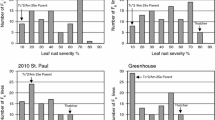Abstract
By using a high-density AFLP marker linkage map, six QTLs for partial resistance to barley leaf rust (Puccinia hordei) isolate 1.2.1. have been identified in the RIL offspring of a cross between the partially resistant cultivar ’Vada’ and the susceptible line L94. Three QTLs were effective at the seedling stage, and five QTLs were effective at the adult plant stage. To study possible isolate specificity of the resistance, seedlings and adult plants of the 103 RILs from the cross L94×’Vada’ were also inoculated with another leaf rust isolate, isolate 24. In addition to the two QTLs that were effective against isolate 1.2.1. at the seedling stage, an additional QTL for seedling resistance to isolate 24 was identified on the long arm of chromosome 7. Of the eight detected QTLs effective at the adult plant stage, three were effective in both isolates and five were effective in only one of the two isolates. Only one QTL had a substantial effect at both the seedling and the adult plant stages. The expression of the other QTLs was developmental-stage specific. The isolate specificity of the QTLs supports the hypothesis of Parlevliet and Zadoks (1977) that partial resistance may be based on a minor-gene-for-minor-gene interaction.
Similar content being viewed by others
Author information
Authors and Affiliations
Additional information
Received: 16 February 1999 / Accepted: 20 February 1999
Rights and permissions
About this article
Cite this article
Qi, X., Jiang, G., Chen, W. et al. Isolate-specific QTLs for partial resistance to Puccinia hordei in barley. Theor Appl Genet 99, 877–884 (1999). https://doi.org/10.1007/s001220051308
Issue Date:
DOI: https://doi.org/10.1007/s001220051308




